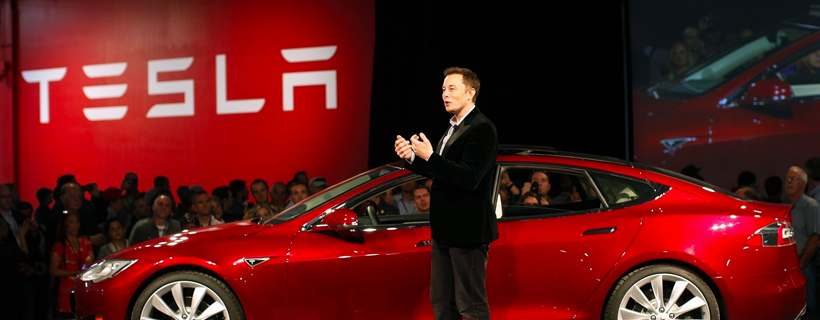- We are positive on the Tesla story given the company’s well-positioned product roadmap around EV, autonomy, solar, and storage.
- Tesla shares are up ~9% after hours as the company made progress on key pieces to the long-term sustainability of the story.
- The “run out of cash” concern still exists, but likely not for long, as it would be effectively ended if the company turns a profit in Sep-18 or Dec-18.
- Musk was more measured on the call, improving investor confidence.
- Model 3 production and profitability remain unchanged.
- Demand for Model 3 likely to increase as more are available for test drives and are seen in the wild.
- Shanghai factory debt financing points to continued investor support.
- One negative from the call: Musk suggested a 2020 total output of 750k-1M vehicles compared to his previous target of 1M.
- See our updated model here.
Close, but still haven’t hit the critical quarter
We were encouraged on many fronts following Jun-18 results, and believe the company is better positioned to capitalize on its mission of accelerating the globe’s adoption of sustainable energy. That said, the company still has several important milestones to hit before reaching escape velocity, the most important of which is achieving sustained profitability. From our perspective, it will take 2 quarters of sustained profitability before the risk of bankruptcy is largely dismissed. That means this risk will still exist at least until the Dec-18 earnings report (likely mid-February). The second most important milestone is around Model 3 production, which will likely take another 6 months of meeting expectations before our concern is eliminated. While we still have some concerns, we believe the company will be successful in navigating past them by Mar-19.
A more measured Musk
It’s an understatement to say investors were focused on Musk’s tone on the call following the Mar-18 conference call and some of his recent behavior. We were expecting a more measured Musk, but were shocked to hear his apologies. His actions on the call were a powerful statement that he’s capable of channeling his energy for the good of the company and it removes a central concern, lifting a weight off the shoulders of Tesla supporters.
Expanding awareness and addressable market for Model 3
The company has shifted from taking reservations to taking orders for Model 3, eliminating the value of the net reservations metric (last reported as 420,000 on July 2), which was used to get a sense for demand. While we no longer have this metric to rely on, we are encouraged that demand for Model 3 is increasing for two reasons. First, to date, there have been relatively few Model 3s on the road to build the all-important Tesla referral network (the key marketing mechanism Tesla has historically used), but that number will effectively double this quarter. Second, Tesla has gone from 8 to 90 stores that have a Model 3 available for test drives in just the last 3 weeks. When spending on average $55,000, the importance of a test drive is understandable. Lastly, an anecdote from the call was encouraging for the size of Model 3’s addressable market. The top 5 cars being traded in for a Model 3 (Toyota Prius, BMW 3 Series, Honda Accord, Honda Civic, Nissan Leaf) are all priced below the average Model 3 selling price. This is evidence that the cost of ownership rationale (tax credit, maintenance, and fuel savings) is resonating with more price-sensitive consumers.
Our profitability timing
The company reiterated they will be GAAP profitable in the Sep-18 quarter and added that they expect to be profitable in perpetuity albeit at varying levels. We have previously taken a hyper-conservative approach to their profitability and expected them to reach the milestone in Sep-20. Given, the additional details around op-ex savings and incremental manufacturing efficiencies, we are moving our profitability target to Dec-18. We are taking a one-quarter conservative approach because of the company’s track record of aggressive goal-setting. That said, whether it’s in Sep-18 or Dec-18 is largely irrelevant in the long run.
Manufacturing efficiencies play into profitability
One of the long-term concerns of the Tesla story is that manufacturing costs will scale with production, creating profitless prosperity. The company’s guidance for capex of $2.5B, which is below the total 2017 level of $3.4B, and our belief of investor expectations of $3B. This is evidence of manufacturing leverage, given total car production will increase ~150% this year and capex will be down 26%. Musk added, “the potential for our existing lines to be able to produce far more cars is much greater than expected.” This means that costs do not scale proportional to production, which is foundational to sustainable profitability.
Financing lining up for Shanghai Gigafactory
The ability of the company to raise debt or equity has been a concern. Tesla reiterated they will not need to raise money to fund operations and separately, outlined that they are closing in on $5B in local Chinese debt financing to build the Shanghai Gigafactory, effectively starting in 2019. We believe this debt financing is representative of continued investor support of Musk and the Tesla mission, which will be tapped in the future as the company continues to expand operations.
Disclaimer: We actively write about the themes in which we invest: virtual reality, augmented reality, artificial intelligence, and robotics. From time to time, we will write about companies that are in our portfolio. Content on this site including opinions on specific themes in technology, market estimates, and estimates and commentary regarding publicly traded or private companies is not intended for use in making investment decisions. We hold no obligation to update any of our projections. We express no warranties about any estimates or opinions we make.
